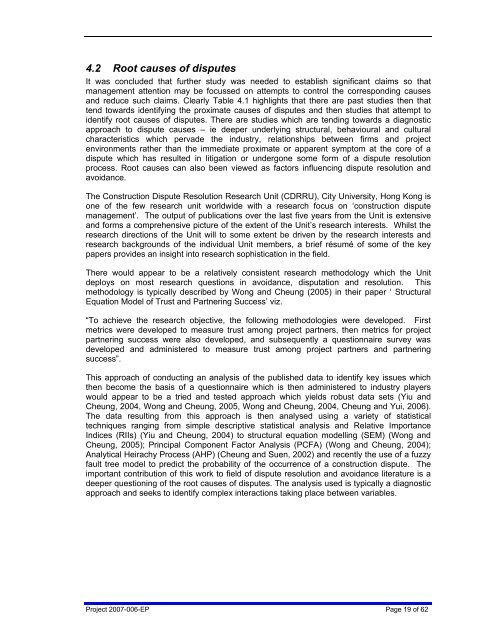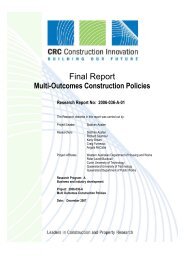Dispute Avoidance and Resolution (literature review) - Construction ...
Dispute Avoidance and Resolution (literature review) - Construction ...
Dispute Avoidance and Resolution (literature review) - Construction ...
Create successful ePaper yourself
Turn your PDF publications into a flip-book with our unique Google optimized e-Paper software.
4.2 Root causes of disputesIt was concluded that further study was needed to establish significant claims so thatmanagement attention may be focussed on attempts to control the corresponding causes<strong>and</strong> reduce such claims. Clearly Table 4.1 highlights that there are past studies then thattend towards identifying the proximate causes of disputes <strong>and</strong> then studies that attempt toidentify root causes of disputes. There are studies which are tending towards a diagnosticapproach to dispute causes – ie deeper underlying structural, behavioural <strong>and</strong> culturalcharacteristics which pervade the industry, relationships between firms <strong>and</strong> projectenvironments rather than the immediate proximate or apparent symptom at the core of adispute which has resulted in litigation or undergone some form of a dispute resolutionprocess. Root causes can also been viewed as factors influencing dispute resolution <strong>and</strong>avoidance.The <strong>Construction</strong> <strong>Dispute</strong> <strong>Resolution</strong> Research Unit (CDRRU), City University, Hong Kong isone of the few research unit worldwide with a research focus on ‘construction disputemanagement’. The output of publications over the last five years from the Unit is extensive<strong>and</strong> forms a comprehensive picture of the extent of the Unit’s research interests. Whilst theresearch directions of the Unit will to some extent be driven by the research interests <strong>and</strong>research backgrounds of the individual Unit members, a brief résumé of some of the keypapers provides an insight into research sophistication in the field.There would appear to be a relatively consistent research methodology which the Unitdeploys on most research questions in avoidance, disputation <strong>and</strong> resolution. Thismethodology is typically described by Wong <strong>and</strong> Cheung (2005) in their paper ‘ StructuralEquation Model of Trust <strong>and</strong> Partnering Success’ viz.“To achieve the research objective, the following methodologies were developed. Firstmetrics were developed to measure trust among project partners, then metrics for projectpartnering success were also developed, <strong>and</strong> subsequently a questionnaire survey wasdeveloped <strong>and</strong> administered to measure trust among project partners <strong>and</strong> partneringsuccess”.This approach of conducting an analysis of the published data to identify key issues whichthen become the basis of a questionnaire which is then administered to industry playerswould appear to be a tried <strong>and</strong> tested approach which yields robust data sets (Yiu <strong>and</strong>Cheung, 2004, Wong <strong>and</strong> Cheung, 2005, Wong <strong>and</strong> Cheung, 2004, Cheung <strong>and</strong> Yui, 2006).The data resulting from this approach is then analysed using a variety of statisticaltechniques ranging from simple descriptive statistical analysis <strong>and</strong> Relative ImportanceIndices (RIIs) (Yiu <strong>and</strong> Cheung, 2004) to structural equation modelling (SEM) (Wong <strong>and</strong>Cheung, 2005); Principal Component Factor Analysis (PCFA) (Wong <strong>and</strong> Cheung, 2004);Analytical Heirachy Process (AHP) (Cheung <strong>and</strong> Suen, 2002) <strong>and</strong> recently the use of a fuzzyfault tree model to predict the probability of the occurrence of a construction dispute. Theimportant contribution of this work to field of dispute resolution <strong>and</strong> avoidance <strong>literature</strong> is adeeper questioning of the root causes of disputes. The analysis used is typically a diagnosticapproach <strong>and</strong> seeks to identify complex interactions taking place between variables.Project 2007-006-EP Page 19 of 62
















